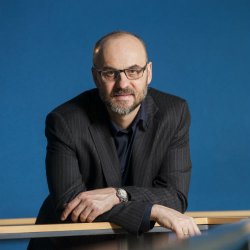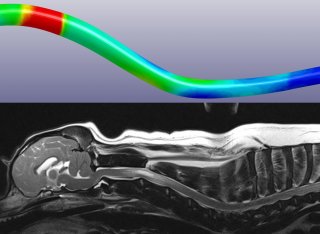
Dr Srdjan Cirovic
About
Biography
Serge Cirovic obtained his undergraduate degree in Aerospace Engineering from the University of Begrade, Serbia, and his MSc (Biomedical Engineering) and PhD (Aerospace Engineering, 2001) from the University of Toronto, Canada. Between 1996 and 2003 he worked as a research consultant at DRDC (Defence Research and Development Canada) on the effect of G-forces on the cardiovascular system of fighter pilots. Dr Cirovic was a research associate at the University of Sheffield between 2003 and 2005 before assuming lectureship at the University of Surrey in 2006. He is the Programme Director of the MSc in Biomedical Engineering and teaches biomechanics to both undergraduate and MSc students. His research interests lie in using computer models to understand the role of mechanical stimuli in the etiology of pathological conditions and in the therapeutic effect of high-amplitude pressure waves.
ResearchResearch interests
Cerebrospinal fluid (CSF) is a clear liquid which surrounds the brain and the spinal cord. CSF flows in a pulsatile manner, driven by the cardiac cycle: in systole CSF is displaced from the cranium into the spinal compartment, in diastole the recoil of the elastic spinal dura mater drives CSF back into the cranium. In pathological situations the communication between the cranial and spinal CSF spaces is compromised and this sometimes results in abnormal accumulation of the fluid in the spinal cord. The fluid-filled cavities (syrinx, syringes) expand with time resulting in sensory loss and in some cases paralysis. The pathogenesis is still unknown which is the main reason why surgical interventions aimed at managing this condition have limited success. My analytical and computer-modelling studies are aimed at gaining better understanding of why and how pathological fluid-filled cavities form, and how they can be managed surgically in the most effective way.
Shock wave therapy is a relatively new therapeutic method used to treat a range of medical conditions. The method emerged from the idea to focus high amplitude pressure waves on kidney stones in order to break them without surgical intervention. Later, the application of the method was expanded to musculoskeletal disorders such as inflammation of connective tissue in the foot (plantar fasciitis and Achilles tendonitis). In spite of its widespread use, the mechanisms through which shock wave therapy acts to relieve inflammation of connective tissue are still unknown. My main interest is in “radial shock wave therapy” in which the pressure waves are generated through collision between two metal objects: an air driven projectile, and an applicator which is in direct contact with the skin. Unlike the more traditional “focused shockwave therapy” where the whole energy is concentrated on a single point, in radial wave therapy pressure waves propagate in all directions and quickly lose intensity as they penetrate from the origin at the skin’s surface into the interior of the body. My experimental, analytical, and modelling studies are aimed at gaining better understanding of the mechanical stimuli generated by this therapeutic technique and of its biological effects.
Research interests
Cerebrospinal fluid (CSF) is a clear liquid which surrounds the brain and the spinal cord. CSF flows in a pulsatile manner, driven by the cardiac cycle: in systole CSF is displaced from the cranium into the spinal compartment, in diastole the recoil of the elastic spinal dura mater drives CSF back into the cranium. In pathological situations the communication between the cranial and spinal CSF spaces is compromised and this sometimes results in abnormal accumulation of the fluid in the spinal cord. The fluid-filled cavities (syrinx, syringes) expand with time resulting in sensory loss and in some cases paralysis. The pathogenesis is still unknown which is the main reason why surgical interventions aimed at managing this condition have limited success. My analytical and computer-modelling studies are aimed at gaining better understanding of why and how pathological fluid-filled cavities form, and how they can be managed surgically in the most effective way.
Shock wave therapy is a relatively new therapeutic method used to treat a range of medical conditions. The method emerged from the idea to focus high amplitude pressure waves on kidney stones in order to break them without surgical intervention. Later, the application of the method was expanded to musculoskeletal disorders such as inflammation of connective tissue in the foot (plantar fasciitis and Achilles tendonitis). In spite of its widespread use, the mechanisms through which shock wave therapy acts to relieve inflammation of connective tissue are still unknown. My main interest is in “radial shock wave therapy” in which the pressure waves are generated through collision between two metal objects: an air driven projectile, and an applicator which is in direct contact with the skin. Unlike the more traditional “focused shockwave therapy” where the whole energy is concentrated on a single point, in radial wave therapy pressure waves propagate in all directions and quickly lose intensity as they penetrate from the origin at the skin’s surface into the interior of the body. My experimental, analytical, and modelling studies are aimed at gaining better understanding of the mechanical stimuli generated by this therapeutic technique and of its biological effects.
Teaching
- ENG2097 Biomechanics
- ENG3173 Clinical Rehabilitation
- ENGM187 Biomechanics
- ENGM259 Computer Methods in Biomed. Eng.
Publications
S. Cirovic, R.M. Bhola, D.R. Hose, I.C. Howard, P.V. Lawford, J.E. Marr, and M.A. Parsons, Simulation of the optic nerve avulsion from a blunt body trauma using a computer model. In press: British Journal of Ophthalmology, 2006.
S. Cirovic, R.M. Bhola, D.R. Hose, I.C. Howard, P.V. Lawford, M.A. Parsons. A Computational Study of the Passive Mechanism of Eye Restraint during Head Impact Trauma. Computer Methods in Biomechanics and Biomedical Engineering, 8(1):1-6,2005.
S. Cirovic, R.M. Bhola, D.R. Hose, I.C. Howard, P.V. Lawford and M.A. Parsons, Mechanistic hypothesis for eye injury in infant shaking: an experimental and computational study. Forensic Science, Medicine and Pathology, 1(1): 53-60, 2005.
S. Cirovic, C. Walsh, and W.D. Fraser. A mathematical study of the role of non-linear venous compliance in the cranial volume-pressure test. Medical and Biological Engineering and Computing, 41(5): 579-588, 2003.
S. Cirovic, C. Walsh, W.D. Fraser, and A. Gulino. The effect of posture and positive pressure breathing on the hemodynamics of the internal jugular vein. Aviation Space and Environmental Medicine, 74(2): 125-131, 2003.
S. Cirovic, C. Walsh, and W.D. Fraser. Wave propagation through a system of coaxial tubes: A model of pulse propagation in the intracranial arteries. Journal of Fluids and Structures, 16(8): 1029-1049, 2002.
S. Cirovic, C. Walsh, and W.D. Fraser. A mechanical model of cerebral circulation during sustained acceleration. Aviation Space and Environmental Medicine, 72(8): 704-712, 2001.
S. Cirovic, C. Walsh, and W.D. Fraser. A mathematical model of cerebral perfusion subjected to Gz acceleration. Aviation Space and Environmental Medicine, 71(5): 514-521, 2000.

